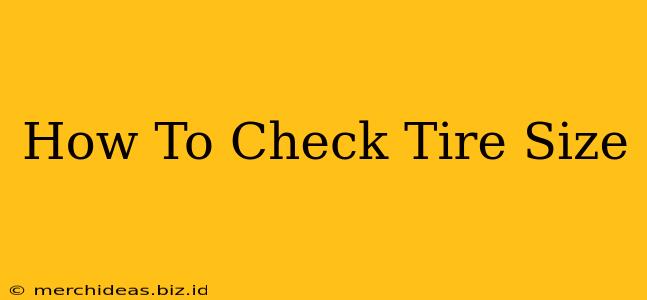Knowing your tire size is crucial for safety and proper vehicle maintenance. Replacing your tires with the incorrect size can impact your vehicle's handling, fuel efficiency, and even your speedometer accuracy. Fortunately, checking your tire size is quick and easy. This guide will show you multiple ways to find this vital information.
Where to Find Your Tire Size Information
There are three primary locations to find your tire size: on the tire itself, on the sticker inside your driver's side doorjamb, and in your vehicle's owner's manual.
1. Checking the Tire Sidewall
The most straightforward method is to examine the sidewall of your tire. The tire size is imprinted directly onto the sidewall. It will look something like this: P215/65R15. Let's break down what each part means:
- P: This indicates that the tire is a passenger vehicle tire. You might also see "LT" for light truck or other designations.
- 215: This is the tire's width in millimeters.
- 65: This is the aspect ratio, representing the tire's height as a percentage of its width.
- R: This indicates that the tire is radial. Almost all modern tires are radial.
- 15: This is the wheel diameter in inches.
Important Note: You'll likely see additional information on the sidewall, such as the load index and speed rating. While important, these aren't necessary to determine your basic tire size.
2. Checking the Driver's Side Doorjamb
Your vehicle's manufacturer includes a sticker on the driver's side doorjamb (usually near the latch) that lists the recommended tire size and inflation pressure. This sticker is a valuable resource and should always be consulted when choosing replacement tires.
3. Consulting Your Owner's Manual
Your vehicle's owner's manual contains comprehensive information, including the recommended tire size and other specifications. This is a particularly helpful resource if you're having trouble locating the information elsewhere.
Understanding Tire Size Codes
While the tire size code is relatively straightforward, understanding each component is crucial for making informed decisions about tire replacements. Incorrect tire sizing can lead to:
- Speedometer Inaccuracy: Incorrect tire size can affect your speedometer readings, potentially leading to inaccurate speed estimations.
- Handling Issues: Improperly sized tires can significantly impact your vehicle's handling, making it less responsive and potentially unsafe.
- Fuel Efficiency Problems: Using the wrong tire size can negatively influence your vehicle's fuel economy.
- Wear and Tear: Incorrect tire size might result in uneven tire wear and premature tire failure.
What to Do With Your Tire Size Information
Once you've determined your tire size, you can use this information to:
- Buy Replacement Tires: This is the most obvious application. Knowing your tire size ensures you purchase the correct replacement tires.
- Research Tire Options: You can use your tire size as a starting point to research different tire brands, types, and features that best suit your driving needs and preferences.
- Ensure Proper Inflation: The information on your doorjamb sticker usually includes the recommended tire pressure for your vehicle. Maintaining correct tire inflation is essential for safety and fuel efficiency.
Knowing your tire size is a simple yet crucial aspect of vehicle maintenance. By following the steps outlined above, you can easily locate this information and make informed decisions to ensure your safety and the optimal performance of your vehicle. Remember to always consult your owner's manual for the most accurate and up-to-date information.
